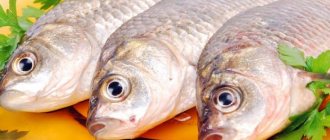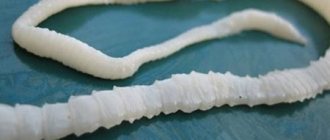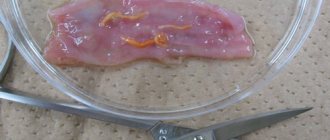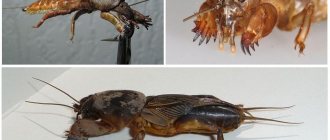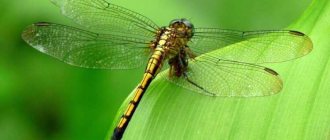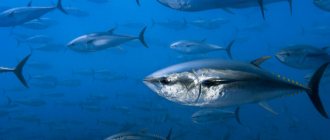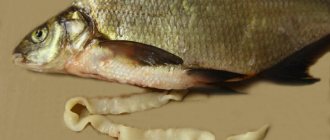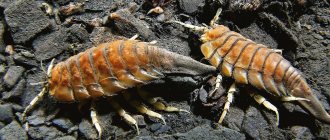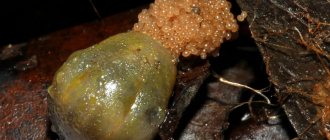Published by: Parazitolog in Parasites in Animals March 5, 2021
Tapeworm in fish is a tapeworm that can cause deadly diseases in humans, for example, diphyllobothriasis. Tapeworm is especially dangerous for children, as when infected with this parasite, a child may experience delayed growth and development, diseases of the circulatory system, and weakened immunity.
- 1 Worms in fish
- 2 Tapeworm in fish - what is it?
- 3 Life cycle of tapeworm
- 4 Types of tapeworm
- 5 Is tapeworm in fish dangerous for humans?
- 6 Symptoms of tapeworm disease in humans
- 7 What does fish look like with tapeworms?
- 8 Tapeworm in dried and smoked fish: how to identify
- 9 Prevention of tapeworm in fish
Worms in fish
Rich in minerals and rare trace elements, fish is a common product in the diet of almost every person.
Few people think about the fact that fish can be dangerous to human health, and this is due to the high risk of infection with worms when consumed by the inhabitants of rivers and seas/oceans.
There are so many diseases that can be transmitted along with worms when eating fish that scientists have divided them into a separate group and called it “fish helminthiasis.” The danger lies in the fact that fish infected with worms are absolutely indistinguishable from healthy ones, and meanwhile, research confirms that all inhabitants of freshwater bodies of water, as well as seas and oceans, can be carriers of eggs and larvae of worms.
Tapeworm in fish. It is worth knowing that even buying fish and seafood in a specialized store does not guarantee the purity of the product. In accordance with regulations, each fish carcass must be checked for invasive contamination.
According to sanitary standards, it is believed that if the number of individuals of non-viable helminths exceeds 5, then the product must be disposed of. A lower indicator allows the product to be sold, but with the condition that before eating it must be subjected to deep heat treatment.
Sexually mature worms, as well as their larvae, can be found in any part of the fish, but most often helminths are found in the liver, gills, muscle tissue, belly or head of the fish. There are also types of parasites that are located in milk and caviar bags!
What to do if you feel bad about throwing away your catch?
It is important to know! If the fish contains a sexually mature parasite, then it is clear that it is already full of larvae.
Unfortunately, this fact does not scare many fishermen, and it’s a pity to throw away another trophy. In this case, they hope to neutralize the fish through careful heat treatment. It is very important to gut the fish and remove the worms with all their segments. The larvae are guaranteed to die if the fish is exposed to:
- Freezing, at a temperature not higher than -20 degrees. At this temperature, fish carcasses are kept for about 3 days.
- Deep salting, using a salt concentration of at least 12 percent relative to the weight of the fish. In such conditions, the fish is kept for at least a week.
- Boil for 30 minutes or fry for at least 15 minutes, first cutting the fish into small pieces.
- Roasting over an open fire.
- Hot smoking for at least a couple of hours.
It should be remembered that small larvae can easily get on both your hands when cutting and kitchen utensils. Therefore, after such work, it is better to wash your hands with soap (laundry soap), as well as kitchen utensils.
Unfortunately, infected fish do not meet high taste standards, since parasites do not allow it to develop normally for a long time.
On a note! Naturally, dishes made from raw or lightly salted fish are considered the most dangerous for humans in terms of parasite infection. Fish caviar, as well as dried fish or cold smoked fish should also be included in the dangerous category. If fish is salted in a low concentration of salt or the heat treatment process is limited, then there is a high probability that the larvae will enter the human intestine and parasitize there for a long time.
This parasite most affects the carp family, and among this family, bream and crucian carp are considered the most vulnerable. In salt water the larvae do not feel as comfortable as in fresh water, although pollock is often found with tapeworm larvae.
Important to remember! Sea fish arrives at retail outlets after deep freezing, after which the fish is also subjected to heat treatment. Such fish can be eaten without fear. If you adhere to the complete technology for preparing fish, as well as comply with sanitary and hygienic standards, then the risk of infection with parasites can be reduced to zero.
To protect yourself from the risks of infection with various worms, it is better not to eat dried fish, as well as cold smoked fish, especially those purchased at the market, since it is unlikely that any seller subjects their products to tests for the presence of parasites. Such fish is not only tasty, but also dangerous to human health.
Tapeworm in fish - what is it?
The tapeworm is a tape parasite that attaches to the inner walls of the intestine with suckers and hooks in its head.
It can reach several meters in size, and survives even with only a head segment. Its entire body is divided into uniform sections that can tear off and leave the wearer's body. The number of these segments corresponds to the number of possible eggs the parasite can lay.
There are several types of tapeworms: bovine and pork tapeworms, dwarf tapeworms, dog tapeworms, and wide tapeworms. The differences between them are the method of entry into the human body and the size of the worm itself.
Many people believe that parasites in the intestines lead exclusively to rapid weight loss, but this symptom can be considered the most innocent. The most dangerous thing is suppression of the immune system and the development of secondary diseases.
What species are susceptible to invasion?
The broad tapeworm was found in 47 species of fish. River dwellers most often suffer from helminths: crucian carp, rudd, silver bream, asp, roach, pike. The worm especially often penetrates the body of bream: sometimes, worms are found in the entire catch.
Tapeworm fish are usually found in polluted water bodies. There is a lot of it in areas of the Upper and Middle Volga, a number of lakes in the Novgorod and Tver regions, and the Mozhaisk reservoir. In some ponds in Central Russia, all the crucian carp living in them are infected with worms.
Life cycle of tapeworm
Externally, beltworms look like yellowish or white worms about a centimeter thick and 5 to 8 centimeters long. At the front end of the worm there are special organs with which it attaches to the organs of its host.
The life cycle of plerocercoids begins with the fact that sexually mature worms lay eggs in the intestines of fish-eating birds (pelicans, gulls, cormorants, etc.). From there, the eggs of parasitic worms fall into bodies of water, where larvae hatch from them.
Helminth larvae are swallowed by the first intermediate hosts - microscopic crustaceans. Fish eat crustaceans and become infected with ligulosis themselves. In the body of fish, worms grow to significant sizes and at the end of their life cycle enter the intestines of birds.
The general life cycle of a tapeworm is approximately the same for all parasites:
- eggs fall onto the soil, grass or into water with the feces of the last carrier (many easily survive wintering and remain viable);
- in the process of feeding animals, eggs enter the body of intermediate hosts; the developed larva of the parasite spreads through the circulatory system into the muscle tissues and internal organs of the animal;
- Through meat, the parasite enters the human body, where it develops into a full-fledged adult, which begins reproduction for a new development cycle.
Disposal
Many people are frightened when, during gutting, worms move in the insides, looking like long white ribbons. They are hesitant to use such fish for cooking and may give it to domestic or street animals. This is strictly forbidden, since the tapeworm will enter the body of a cat or dog and begin to parasitize it. Tapeworm fish should be disposed of: put in a plastic bag and thrown into the garbage chute so that the animal does not get it.
Fish in which a parasite was discovered while fishing is also subject to disposal. If you release it back into the pond, there it will become instant prey for birds. Then their excrement with larvae will get into the water and become food for Cyclops crustaceans, which, in turn, are food for fish. Suspicious individuals are burned or buried.
Types of tapeworm
Bovine tapeworm: A parasite that is considered one of the longest to live in the human body is the bovine tapeworm. As an intermediate carrier before humans, it parasitizes cattle; humans, in any case, remain the final infected host.
Tapeworm in fish. The maximum recorded length of an individual bull tapeworm is 22 meters, but the average is 12 meters. With a thickness of 2 mm, even such a long intestinal parasite can exist in the human body for many years without causing serious discomfort.
These worms do not have their own digestive system, but absorb nutrients directly through the body. Infection occurs due to insufficient heat treatment of meat, because the eggs of the parasite are found in the muscle tissue of cows. Employees of meat processing plants, slaughterhouses, farms and food processing plants are susceptible to teniarinosis (infection with bovine tapeworm).
Pork tapeworm parasite: A smaller parasite, the pork tapeworm, causes the disease taeniasis. The localization of the disease is East Asia, Latin America and Africa, and in Russia – the Krasnodar Territory. The intermediate carrier before the human body is pigs, and it does not matter whether they are wild boars or domestic farm animals.
Taeniasis is dangerous because humans are the last carrier, which means that the colony of worms
will multiply until it destroys the host. Due to the way it is attached, pork tapeworm can damage the walls of the intestines or internal organs.
Broad tapeworm: what is tapeworm in fish? This is a tapeworm - a wide tapeworm that enters the human body with raw or poorly processed fish meat. It rarely exceeds several meters in length, but this makes it no less dangerous for the life of its owner.
The life cycle of this parasite is more varied than that of parasites of cows or pigs. The entire chain of carriers and rebirth of the tapeworm is as follows:
- The worm egg in water degenerates into a larva;
- coracidium settles in small crustaceans;
- the fish’s body becomes infected through feeding on crustaceans;
- the parasite spreads to all tissues of the fish’s body (bream, perch, carp);
- a person becomes infected through meat or fish by-products.
As you can see, humans again remain the final carrier (along with animals that eat fish, such as cats), which means there is a particular danger of the parasite being in the body. What are fish tapeworms and what diseases do they cause to humans? These are anemia, anemia, problems with the gastrointestinal tract. Due to a decrease in the number of beneficial microorganisms, the nervous and immune systems are suppressed.
Disease prevention
Salt water is a less favorable environment for the life of tapeworm, which is why it is less common in marine fish. Accordingly, to avoid infection, it is better to avoid eating river fish. If this is not possible, then you should exclude dried, especially home-made, smoked (cold-processed), lightly salted, and raw fish from your diet.
If you have eaten bream and are not sure of its quality, then it is better to go to the pharmacy for antiparasitic drugs: Fenisal, Pirantel, Piperazine. These drugs have a destructive effect on the tapeworm's body, preventing its organs from developing normally.
Did you know? Some types of tapeworms can destroy 95% if they don't have anything to eat.
Tapeworm is a dangerous parasite that can harm any living organism. It is better to avoid contact with it, and if it already happens that it has entered your body, take measures to destroy it.
Is tapeworm in fish dangerous for humans?
Worms that have reached sexual maturity can cause dangerous complications and stop the functioning of vital internal organs. Most often, tapeworm causes diphyllobothriasis, which is dangerous due to intestinal obstruction.
Worm larvae, when attached to the intestinal walls, can infect the mucous membrane, cause hemorrhages, disrupt the digestion process, and also destroy microflora. In addition, the parasite, whose nutrition occurs through the blood, takes vitamin B12 from the body, which is necessary for the normal functioning of organs.
The helminth poses a significant danger to the body of children. The tapeworm often provokes: retarded growth and development of the child; blood diseases; allergic reactions; prolonged diarrhea; deterioration of the immune system.
Tapeworm in fish. Having consumed an infected fish dish, a person does not suspect that he has become a carrier of a helminth, since early infestation does not cause any symptoms or illness. Parasites can be detected through fecal analysis and blood tests.
Having entered the body, the larva reaches the digestive system and attaches itself to the walls of the small intestine with suction cups. It is there that the helminth begins to develop. The plerocercoid, a representative of tapeworms that is capable of growing into an adult worm in the organs of another host, poses a huge threat to life.
Most often, invasion occurs when eating poorly fried and boiled fish, fresh caviar, as well as insufficient freezing. 30 days after introduction into the body, the female parasite begins to lay eggs, the duration of which can last for many years.
It is possible to defeat parasites!
Antiparasitic Complex® - Reliable and safe removal of parasites in 21 days!
- The composition includes only natural ingredients;
- Does not cause side effects;
- Absolutely safe;
- Protects the liver, heart, lungs, stomach, skin from parasites;
- Removes waste products of parasites from the body.
- Effectively destroys most types of helminths in 21 days.
There is now a preferential program for free packaging. Read expert opinion.
Read further:
Fish parasites: helminths parasitizing sea and river fish
Worms in fish: are there river or sea fish? Is it possible to eat raw or salted fish with worms?
Tapeworm in humans: what are the signs of infection, can it be in fish and how to treat
What can you become infected with opisthorchiasis when consumed? Dangerous foods
Roundworms in the intestines: signs and symptoms of infection, methods of treatment and removal
What is molluscum contagiosum and how can you get infected with it?
Symptoms of tapeworm disease in humans
Due to the active life of the parasite, pathological processes occur in the intestinal system in people.
The most common signs of infestation appear:
- nausea and gag reflexes;
- painful syndromes in the peritoneum;
- loss of strength, weakness;
- weight loss;
- deterioration of intestinal function - diarrhea, constipation;
- loss of appetite.
Tapeworm infestation is accompanied by a decrease in immunity and the occurrence of concomitant pathologies. The first symptoms should not be ignored: therapy in the initial stages is quick and effective.
Symptoms of infection
Parasitic infection, unfortunately, cannot always be detected on time. The parasite adapts well to the host’s body and for a long time its vital activity does not have a negative impact on the functioning of internal systems.
Gradually, alarming symptoms begin to appear, indicating tapeworm infection. Many people complain about:
- Headache.
- Dizziness.
- General weakness.
- An emerging feeling of nausea.
Appearance deteriorates, dark circles appear under the eyes. Abnormal bowel movements occur. Ribbon-shaped parts of the parasite can be seen in the stool. If there is a large accumulation of worms, a person himself may feel some movement in the intestines and feel a tingling sensation.
Take a tapeworm test
This cannot be ignored. Parasites lead to psychosomatic disorders, poisoning a person with their neurotoxic effects.
The spread of parasites in the body leads to constant bursting pain in the lower abdomen. Regularly a person feels severe bloating. There may be occasional nausea and vomiting.
The combination of symptoms indicates the need for hospitalization as soon as possible. Conservative treatment is not always effective; surgery may be necessary.
What does fish with tapeworm look like?
Tapeworm in fish. If you decide to clean the caught fish, but are surprised to find that there are worms inside it, then the fish was sick with ligulosis. Fish ligulosis is caused by tapeworms and is a dangerous disease that can threaten the existence of fish in freshwater bodies.
If belt worms (belt helminths, plerocercoids) live in the abdominal cavity of the fish, then the fish is sick with ligulosis. The life cycle of worms includes a change of several hosts. The final hosts are fish-eating birds, and fish play only the role of an intermediate host.
As a rule, tapeworms live in the digestive tract of freshwater fish: bream, rudd, roach, crucian carp and other cyprinids.
A fish infected with tapeworms quickly weakens and exhibits a disturbance in the basic physiological functions of the body, up to complete atrophy of vital organs.
Typically, fish with ligulosis swim upside down or on their sides near the shore or in shallow water - it is easier for them to get food there. Externally, the fish does not look the best. Her abdomen is swollen and quite hard to the touch.
The fish itself, in comparison with its other counterparts, has a much smaller body weight. She is emaciated and underdeveloped. When strong excitement begins on the water, the weakened fish cannot go to depth and remains floating on the surface, where it is nailed to thickets of reeds, snags, etc.
It happens that due to the abundance of worms, the stomach wall of an infected fish ruptures and the parasites go into the water. A final conclusion about ligulosis can be made only after opening the fish and detecting helminths in its digestive tract.
Most often, mass infection of fish with tapeworms occurs in low-flowing water bodies - ponds, lakes, estuaries, etc. Since fish with ligulosis move sluggishly and swim on the surface, they often become prey for fish-eating birds. In the body of birds, worms find their final refuge, where they complete the cycle of their life development.
Folk remedies
Alternative medicine has effective methods of combating parasites, but they require long-term use and are not always able to completely get rid of worms. First of all, you need to change your diet, making it dietary.
Vegetables, fruits, cereals and wheat bran stew may not be the height of culinary art, but they are good for removing parasites.
During this period, it is recommended to eat pumpkin seeds with lingonberries. It is enough to grind these ingredients and eat 1-2 spoons on an empty stomach, wash down with plenty of water.
Another appointment should be in a couple of hours. It is better to abstain from other foods until lunch. Cleansing enemas will remove parasites accumulated in the large intestine.
Important! To completely get rid of a parasitic infection, you need to combine medication and alternative treatment.
Tapeworm in dried and smoked fish: how to identify
You can identify helminths in fresh fish by its behavior: the fish swims slowly and sluggishly on the surface of the water; there is a slight swelling in the abdominal area; By pressing on the abdomen, you can see fragments of the parasite.
Infected fish are more common in spring and summer, as well as in early autumn. If you catch a fish with helminths, you should not release it: the tapeworm is capable of leaving offspring. It is difficult to distinguish an infected catch from a healthy one, but the taste of such a product is much worse and there are fewer nutrients.
Tapeworm in fish. Parasites in dried products can live in the form of eggs. Mature individuals do not survive under processing conditions and are found only fresh. When buying dried fish, a person may lose vigilance and not inspect it before purchasing. This can lead to negative consequences.
Therefore, you should purchase fish delicacies from trusted retail outlets, and also check the availability of the necessary documents. In smoked fish, the parasite can continue to exist if the heat treatment is poor. Not all manufacturers follow the smoking rules. If you have doubts about the products you are purchasing, you should refuse to purchase.
How to cook properly
If a helminth is discovered when cutting fish, it should be carefully pulled out so that fragments do not remain in the product. Having removed the entire worm, do not forget that the larvae and eggs can continue to exist in other cavities of the fish’s body and cause infection in humans. To prevent this from happening, familiarize yourself with the basic principles of cooking it:
- Cooking. Before cooking, infected fish should be soaked for several hours in a solution with salt. It should be cooked for at least half an hour to ensure complete death of the helminth larvae.
- Frying. It is recommended to fry the product for at least 15 minutes. It is best to cook fish by cutting it into small pieces - some of the larvae may remain in large portions. You can also grind it with a meat grinder or blender and make minced fish.
Smoking. This is one way to avoid the possibility of helminthic infestation. It is best to choose a hot processing method or baking over an open fire.
Purchased smoked fish is not guaranteed to be completely free of parasite larvae, so you should be careful when purchasing the product or preparing it yourself. Drying. This process can destroy adult individuals, but is not able to eliminate parasite eggs.
Before purchasing a finished product, you should carefully inspect it for the presence of swollen body fragments. Freezing. The presence of tapeworm in purchased fish does not mean that the product should necessarily be thrown away. You can try to cook it correctly, following the rules of proper heat treatment.
After removing the parasite from the internal organs, it is recommended to freeze the aquatic inhabitant, leaving it in the freezer for 2-3 days. Using deep freezing, you can get rid of individuals living in muscle tissue. To do this, remove the entrails from the belly, wash the fish with running water, cut it into small pieces and send it to the cold at a temperature of -18°C.
Products weighing up to one kilogram are frozen for 10 hours or more, larger ones for 24 hours. For complete safety, you should deep freeze the fish and leave it in the freezer for three days, at a temperature of at least -20°C. The product should not be eaten raw. Only prolonged heat treatment guarantees the death of parasites.
When preparing dried fish at home, wash it thoroughly, take out the insides, and soak it in a bowl of salt. After this, hang it to dry.
Are worm eggs destroyed by freezing?
Parasites die 3 hours after freezing, according to experts. Is it so? Of course, when a certain temperature regime is created, the parasites die. But what should the indicators be? To destroy helminth eggs within 3 hours, the temperature must be below 40 degrees. At temperatures of 30 degrees, the procedure for “neutralizing” meat takes at least 72 hours.
We suggest you familiarize yourself with Small white bugs in the soil of indoor plants
Long-term storage at extremely low temperatures increases the likelihood of the death of most parasites in the product.
In most household freezers, the temperature varies at least 18 degrees. What to do in this case? It takes at least 4 days for the eggs and the parasites themselves to be completely destroyed. Only after this time has expired can you eat fish and meat without preliminary heat treatment. Otherwise, salted lard or ready-made stroganina can cause parasites to enter the human body.
Recommendations for freezing meat and fish:
- Buy frozen food only from large stores. In supermarkets, all rules for temperature conditions and storage of meat and fish are observed.
- Before including a raw product in food, it must be kept in the freezer for at least 4 days.
- When cutting and processing raw meat, poultry and fish, use a special cutting board and knife. Be sure to heat treat all used kitchen appliances at the end of the cooking process.
Careful heat treatment increases the likelihood of avoiding invasion
Fluctuations in temperature cause parasites to die. Considering the whole process using pinworms (the most common parasites among people) as an example, we can note the following relationship:
- At a temperature of 23-40 degrees – favorable conditions.
- At temperatures above 55 degrees, they die within a few seconds.
That is why, in order to prevent worms from entering the human body, it is recommended to boil underwear and bed linen.
As for food products such as meat and fish, they must be heat treated for 30-60 minutes before consumption.
A special need for boiling underwear and bed linen arises when there is an infected adult or child in the house. It is mandatory to iron the laundry after washing.
Children's toys and household items should be cleaned with detergent. In winter, carpets and soft toys are taken outside and kept in the cold for at least an hour. Daily wet cleaning using detergents is mandatory.
Each person is free to decide for himself which path to choose: to prevent infection or to be treated for worms. Medicines against parasites have a toxic effect on human internal organs, which can lead to the development of serious complications. No matter how difficult it may seem to prevent helminthic infestations, this method is much cheaper and safer.
Fish is a favorite food of many people, consumed all over the world. The variety of types and taste makes it an indispensable source of nutrients and requires certain skills in cutting and cooking. But often fish are a source of parasite infection.
It is not always possible to recognize infected fish - this is determined by the type of helminth, the environment from which the fish was caught, the skills of the fishermen and compliance with sanitary standards.
To kill parasites in fish, fish undergoes sanitary examination and processing on fishing vessels and fish processing enterprises, but it is still worth knowing about the danger it contains, because the place from which it was brought is not always precisely known.
